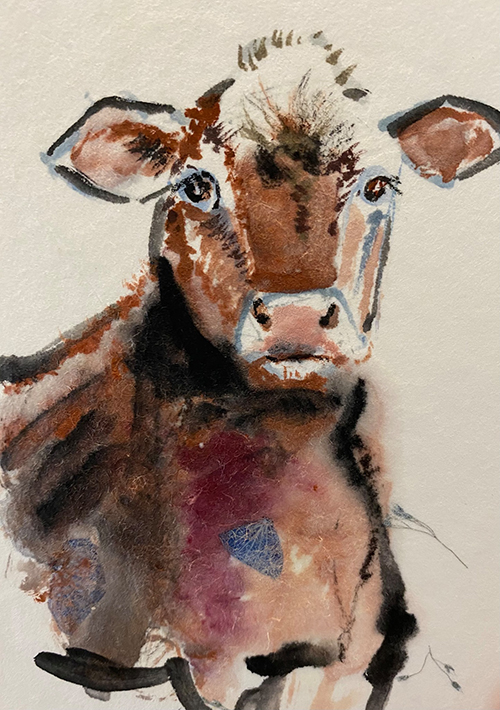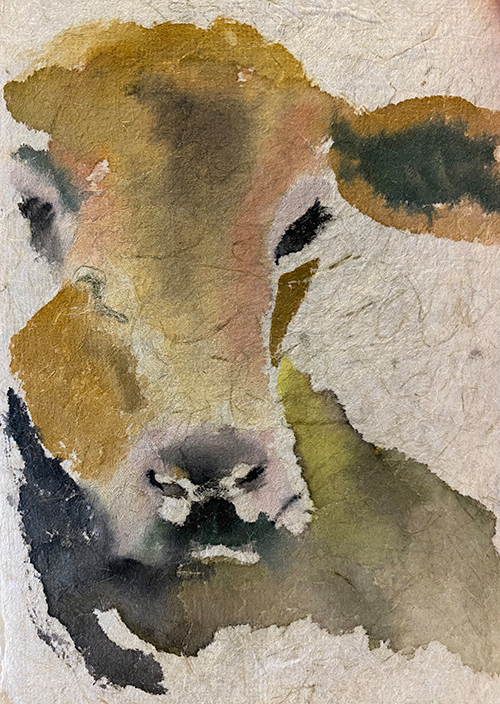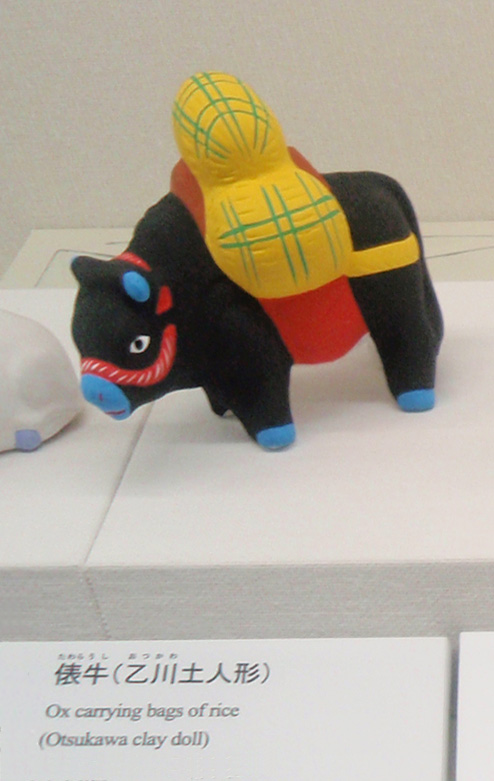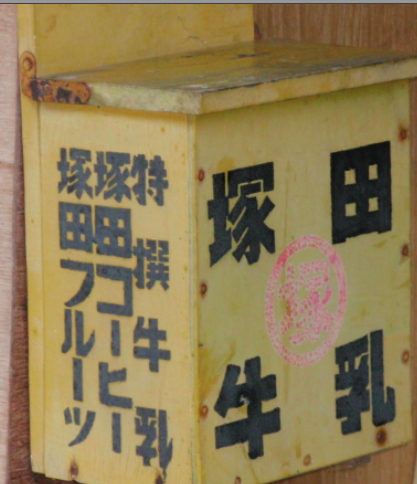93. The "Cow" Radical: 牛
The term "bovine simplicity" derides cows for lacking complexity, content as they are to stand in a field and mindlessly munch grass. The "cow" radical is also quite simple, but that comes as a relief in any kanji context.
The Japanese call this radical うし, a name matching the Joyo kun-yomi of the autonomous 牛 kanji:
牛 (97: cow)
In this character, 牛 is the on-duty radical.
The 牛 shape consists of only four strokes, most rectilinear. Henshall says in his newer edition (the source of all etymologies in this Radical Note) that 牛 is based on the pictograph of the "head of a cow or bull." The cross line (I suppose he means the top one) indicates either "ears" or the "crown of the head," possibly as seen from behind.

Art by Kit Pancoast Nagamura

Art by Kit Pancoast Nagamura

Photo Credit: Eve Kushner
In a display of locally made dolls and toys at Nagoya Castle, this 土人形 (つちにんぎょう: clay doll) depicts a 俵牛 (たわらうし: ox carrying bags)—specifically, bags of rice. The 乙川 (おつかわ) part of the identifying information refers to a neighborhood in the city of Handa, which is in Aichi Prefecture on Honshu. People in 乙川 began making such dolls after a man from there became fascinated with clay dolls in Kyoto and brought the technique back to his hometown. A fuller explanation of this image appears in essay 1041 on 乙 (second (in order or quality)).
The Name of the Radical on the Left
When the "cow" radical becomes thin and slides to the left side of a kanji, we can use the name うしへん, where へん (偏) means "left side of a kanji." (For more on this, see Radical Terms, and check the fourth part, "Radical Positions.") The term うしへん applies to the on-duty radical in these five kanji:
物 (387: thing; object; person)
牧 (586: to raise livestock; pasture)
特 (760: special)
犠 (1140: sacrifice)
牲 (1474: sacrifice; victim)
Photo Credit: Eve Kushner
Sometimes it makes sense for the "cow" radical to appear in a kanji. That's true of 牧 (586: to raise livestock; pasture). As Henshall explains, the radical means "cow," and the 攵 means "to beat with a stick." Thus, 牧 represents "to herd cattle with a stick" and by extension "to graze animals," also symbolizing the land where they graze.
In the black line above, we find both 牧 and 牛 in these words:
牧場 (ぼくじょう: farm)
牛乳 (ぎゅうにゅう: cow milk)
Thus, the sign showcases the two shapes of our radical. The first black word is 高原 (こうげん: highland), though the initial kanji appears in a variant form, 髙. I must have taken this photo in Nikko (a city in Tochigi Prefecture on Honshu). That area is a highland, and 高原牧場牛乳 is the name of a shop selling milk and other products. The messy red writing says 新鮮でうまい, consisting of 新鮮 (しんせん: fresh), followed by で (and) and うまい (delicious).
Cow milk was introduced to Japan as early as the year 645, but only members of the imperial household had access to it until the Meiji Era (1868–1912). At that point common people began drinking milk.
When it came to consuming cows themselves, the Japanese long believed that these animals were exclusively for physical labor, so people didn’t eat beef until a Westernization movement called 文明開化 (ぶんめいかいか: civilization and enlightenment) began in 1868. They then decided that it was advanced or enlightened to enjoy beef, given that Westerners did so. Thus, the abbreviated term 開化 (かいか: civilization; enlightenment) made it into the name of a dish—namely, 開化丼 (かいかどんぶり or かいかどん: beef and egg on rice).
Curved Horns
As the 牛 shape evolved, says Henshall, the cow horns were prominent at one stage. Indeed, Wiktionary shows how the top once curled up to represent horns:

The large red banner in this photo features our radical with partly the same sort of curvature:
Photo Credit: Eve Kushner
The 物 (387: thing; object; person) kanji appears here in 名物 (めいぶつ: famous product), referring to たこ焼き (たこやき: battered and fried balls containing octopus and other ingredients). You can learn more about this image in essay 2038 on 須 (indispensable).
It's a mystery to find the "cow" radical in the ultra-common 物. A "cow" can be inside a person?! Henshall explains that the right-side phonetic originally represented "fluttering streamers of different colors," then came to mean "not" while conveying the associated meaning "various." Thus, 物 meant "cow of various colors," implying a mottled hide. After that, he says casually, the meaning of the character generally shifted to "things." Okay ... but why?!
Photo Credit: Eve Kushner
This sign from Osaka features the following large words:
管理 (かんり: management)
物件 (ぶっけん: property (real estate))
Together they form 管理物件 (real estate under the management of a person or company).
The side-by-side characters in 物件 afford a visual treat, showcasing our radical in its two forms, though it's not 牛 but 亻, a variant of the "person" radical, that's on duty in 件 (660: matter, case). As to why that kanji contains a cow, Henshall says that the 牛 component is an abbreviation for a more elaborate character that originally meant "to lead a cow by a rope" and by extension came to mean "to be pulled/bound." Thus, 件 represented "person who is bound and not free," which is to say "slave." He adds that in ancient China a slave was regarded as no more than an object, so 件 came to have senses such as "thing." Incidentally, I blogged at length about an animal-related aspect of this interesting kanji.
The second line in the sign again contains 物件:
当物件に関するお問い合せ先
If you have an inquiry about this building, contact the following company
当- (とう-: this; the said); に関する (にかんする: concerning);
お問い合せ (おといあわせ: inquiry); -先 (-さき: "destination" of an inquiry)
Contact information follows on the sign.

Photo Credit: Eve Kushner
Another extremely common kanji contains an ill-fitting "cow" radical. Henshall says that 特 (760: special) combines "ox, cow" with 寺 (temple), a phonetic that might contribute the associated sense "single young male." If so, 特 once meant "bull." Alternatively, the phonetic could mean "to stand upright," making the whole character mean "stud bull." Henshall writes, "Bulls were often taken for sacrificial purposes, and the ones selected tended to be of the highest quality, hence the sense 'special.'"
In a photo of a box for milk deliveries to a customer's home, we find 特 in 特撰 (とくせん: specially selected, choice), where 撰 is non-Joyo. Stacked vertically, those two kanji illuminate how similar the "cow" radical and "hand" radical can look when they're on the left sides of characters. We then encounter 牛乳 (ぎゅうにゅう: milk) again. The phrase 特撰牛乳 means "choice milk."
The image also includes three instances of the surname 塚田 (つかだ). As for the remaining words, the company isn't actually delivering coffee or fruit but rather コーヒー牛乳 (coffee-flavored milk) and フルーツ牛乳 (fruit-flavored milk).
Sacrificial Cows
The following etymologies (which go back to ancient China) reflect associations between cows and religious sacrifices:
犠 (1140: sacrifice)
The left side means "cow, ox." The 義 on the right originally meant "animal sacrifice." Thus, the whole character represented "ox sacrifice" or more generally "animal sacrifice," according to three researchers Henshall cites. Another maintains that the right side is just the phonetic here, originally contributing the associated sense "young male (ox)." For sacrificial purposes it had to be of a single color. Thus, "single color" became the associated sense of the right side, giving the overall sense "young ox of a single color." Henshall notes that with this alternate interpretation, "sacrifice" is an extended sense.
牲 (1474: sacrifice; victim)
An old form features not the "cow" radical on the left but rather 羊 (sheep). The right side is 生 (live, birth), which one scholar sees as a phonetic with the associated sense "pure." The whole thing would then mean "sheep cleansed for sacrifice." Another researcher views the right side as meaning "live," giving 牲 the sense "live bull for sacrifice." Two more scholars think the 生 contributes both meaning and sound. From that point of view, the entire character represents "live bull cleansed/prepared for sacrifice," which generalized to just "sacrifice."
